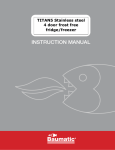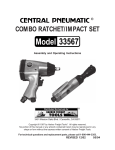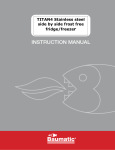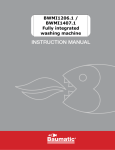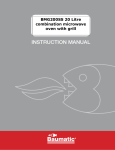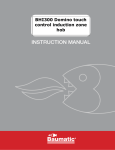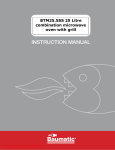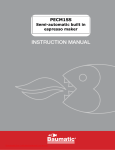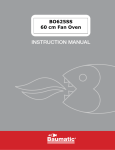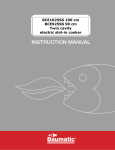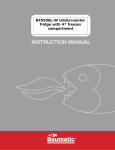Download Baumatic TITAN5 side-by-side refrigerator
Transcript
TITAN5 Stainless steel 4 door frost free fridge/freezer s USER MANUAL FOR YOUR BAUMATIC TITAN5 Stainless steel 4 door 607 litre frost free fridge/freezer NOTE: This User Instruction Manual contains important information, including safety & installation points, which will enable you to get the most out of your appliance. Please keep it in a safe place so that it is easily available for future reference, for you or any person not familiar with the operation of the appliance. DD 08/12/11 2 Contents Environmental note Important safety information Specifications of your fridge freezer Description of the appliance 4 5–6 7-9 9 The fridge section Adjustable safety glass shelves Crisper drawers Full width pantry Fridge section door storage compartments General and bottle shelf height adjustment The dairy compartments The freezer section Using your Baumatic fridge freezer Before switching on During first use The control panel Switching on the appliance Setting the temperature in the fridge section Setting the temperature in the freezer section Express chill mode Express freeze mode The water filter change neon Arranging and storing food in the fridge section 10-15 11 12-13 13 13-14 14 14 15 16-21 16 16 17 17 17-18 18 19 19-20 20 20-21 The **** freezer compartment Freezing fresh food Tips on freezing Storing commercially frozen food Defrosting frozen food In the event of a power cut The dispenser control panel The safety lock Setting the time of day Using the water dispenser Door left open alarm The ice maker How the ice maker works Ice maker advice and maintenance Switching the ice maker off Dispenser and ice maker warnings Saving energy when using your fridge-freezer Cleaning and maintenance The defrost drain hole Replacing the light bulb Changing the water filter Installation Electrical connection Positioning Installation preparation Attaching the handles Removing the right hand door Removing the left hand door Removing the upper freezer drawer Removing the inner compartment of the lower freezer drawer Adjustable feet Levelling the doors Water supply connection Using the water dispenser for the first time Using the ice maker for the first time Troubleshooting Baumatic consumables Technical data Contact details 22- 24 22-23 23 23-24 24 24 25-27 25 26 26 27 27-29 27-28 28 28 29 29-30 31-37 32 33-34 35-37 37-48 37-38 38-40 40 41-42 42 42-43 44 44-45 45 46 46-47 47-48 48 48-53 54 55 56 3 Environmental note Note: Before discarding an old appliance, switch off and disconnect it from the power supply. Cut off and render any plug useless. Cut the cable off directly behind the appliance to prevent misuse. This should be undertaken by a competent person. Disable the door lock to make sure that children cannot get stuck inside the appliance. o The packaging materials that Baumatic uses are environmentally friendly and can be recycled. o Please discard all packaging material with due regard for the environment. 4 Important safety information Your safety is of the utmost importance to Baumatic. Please make sure that you read this instruction booklet before attempting to install or use the appliance. If you are unsure of any of the information contained in this booklet, please contact the Baumatic Advice Line. IMPORTANT: Any installation work must be carried out by a qualified electrician or competent person. Use of the appliance o Your appliance is only designed to be used in the home. It is suitable for storing food that needs to be chilled and refrigerated. If it is used for any other purpose or it is not used correctly, then Baumatic Ltd. will accept no liability for any damage that is caused. o Altering the specification of the appliance must not be attempted for reasons of safety. Before using your appliance o Check the appliance for any signs of transport damage. If you notice any damage, then you should not connect your appliance to your mains supply and should contact your retailer. Refrigerant o Your appliance contains R600a refrigerant, which is a natural gas that does not contain CFCs that can damage the environment. However it is a flammable substance, therefore care should be taken: During the transportation and installation of the appliance, make sure that the refrigeration pipework does not get damaged. If it does become damaged then sources of ignition and open flames should be avoided. Also the room that the appliance is situated in should be thoroughly ventilated. o Do not place any objects on top of the appliance, as this may damage the table top. 5 Child safety o Packaging material should be kept away from children. o Children should not be allowed to touch the controls or play with the appliance. General safety o Do not pull on the power supply cable to remove the plug from your mains supply socket. o Do not pull out or insert the plug with wet hands. o Do not attempt to use your appliance outdoors or any place where it is likely to come into contact with the elements. o Before cleaning the appliance or performing maintenance work, ensure that the appliance disconnected from your mains supply. has been o Never allow the back coils of the appliance to come into contact with the wall surface. o Always ensure that the location where you are installing your appliance is free of stored items such as papers and other flammable materials. o Never block the ventilation openings of the appliance, either on the inside or its exterior. o It is vital to keep your appliance well ventilated, so that there is proper air flow between the bottom of the unit and the plinth/kick plate which it is sitting on. o Do not place electrical devices inside of the appliance, such as mixers or ice cream makers. Service You should not attempt to repair the appliance yourself, as this could cause injury or a more serious malfunction. If you require a service call then please contact the Baumatic Customer Care Department. 6 Specifications of your fridge freezer Dimensions of your appliance o Height: 1771 mm o Width: 908 mm o Depth: 700 mm (excluding handles) Energy efficiency class o Energy class: A Cubic capacities o Gross capacity (fridge): o Gross capacity (freezer): o Net capacity (fridge): o Net capacity (freezer): 428 179 397 160 litres litres litres litres Specifications of the appliance o Freezer star rating: **** o Frost free fridge and freezer 7 o o o o o o o o o o o o o o o o o o o o o o o Adjustable thermostat Electronic control operation LED display Open door warning indicator Temperature rise warning indicator Fast cooling switch Fast freeze switch Fast freeze indicator light Multi airflow cooling system Water dispenser Automatic motor-driven ice maker 2 x freezer drawers Digital control panel 4 x adjustable safety glass shelves 2 x crisper drawers 2 x safety glass crisper covers 2 x bottle shelves 2 x general door shelves 2 x egg racks Wine rack 2 x butter and cheese compartments Full width pantry Adjustable feet IMPORTANT: When you install your appliance it is important to bear in mind its climatic rating. In order to find out the climatic rating of your appliance, you should check the rating plate. The rating plate is located inside of the fridge section. You will need to open the door of your appliance to be able to find it. The rating plate will indicate the ambient temperature range that your appliance will function correctly within. 8 Description of the appliance 9 The fridge section o We recommend that you leave storage space between food items, to allow for good air circulation. o The temperatures in the fresh food compartment are slightly warmer towards the top and cooler towards the base. o Please find below some storage suggestions, that you may wish to follow:1) 2) 3) 4) 5) 6) 7) 8) Eggs, butter, cheese etc Tins, cans, condiments etc Drinks and bottled foods Pickled foods, drinks or cans Meat, poultry, fish and raw foods Pastries, cans, dairy etc Cooked meats, sausage etc Fruits, vegetables or salads 10 Adjustable safety glass shelves o The shelves may be placed in any of the guide slots within the interior of the appliance. They are protected from sliding out. o To remove a shelf: Take off all of the items that are stored on the shelf that you want to remove. Then whilst lifting the front of the shelf, pull it forwards to unhook it from the slots at the rear of the cabinet. o To refit a shelf: When placing a shelf back inside the fridge compartments, place the hooks into the slots at the rear of the cabinet. Lower the front of the shelf back down again. o IMPORTANT: You must ensure that both of the hooks are in slots that are at the same height; otherwise the shelf will not be level. 11 Crisper drawers The crisper drawers are designed to store fruit, vegetables or meat. The temperature inside of them can be adjusted to one that is suitable for the food items being stored. o To increase the humidity in the crisper drawer, turn the dial that is located on the right hand side of the crisper drawer. o When the dial is moved towards “Hi”, the humidity level is increased. The conditions in the crisper drawer are then best suited to storing cucumbers, grapes, oranges, apples, peaches, lettuce and other produce with a high moisture content. o When the dial is moved towards “Lo”, the humidity level is decreased. The conditions in the crisper drawer are then best suited to storing meat, cheese, onions and other produce which is drier. o To remove the safety glass crisper covers, lift up the cover and then pull it towards you (as shown in the line drawing above). 12 o For the storage of meat and fish, we would recommend that they are stored in a foil cover or a vinyl wrap. o Care should be taken when storing tropical fruit (bananas and pineapples etc) and tomatoes. As these types of items can easily deteriorate in a lower temperature. Full width pantry The temperature in the full width pantry can be adjusted, depending on the type of food that you are storing in it. o To control the temperature in the full width pantry, use the airregulator dial on the top of it. There are four settings, going from COLD to COLDEST. o IMPORTANT: Do no turn the air-regulator dial too hard, otherwise you might damage it. o For the storage of meat and fish, we would recommend that they are stored in a foil cover or a vinyl wrap. o Care should be taken when storing tropical fruit (bananas and pineapples etc) and tomatoes. As these types of items can easily deteriorate in a lower temperature. Fridge section door storage compartments o The door liners hold various shelves, which are suitable for storing eggs, cheese, butter and yogurt. As well as smaller packages, tubes, cans etc. o The lowest shelf in each door should be used for storing reasonably sized bottles. 13 o IMPORTANT: IT IS IMPORTANT THAT NONE OF THE SHELVES THAT SIT IN THE DOOR ARE OVERLOADED, AS THIS WILL DRASTICALLY REDUCE THEIR WORKING LIFE. General and bottle shelf height adjustment It is possible to adjust the height of the general shelves and bottle shelves in the doors. o Remove all items from the shelf that you want to adjust the height of. o Hold both sides of the shelf then lift it upwards and pull it towards you. o Place the shelf back into the door at the height that you require and then push it downwards until it locates into position. The dairy compartments IMPORTANT: You should take care not to trap your fingers when opening and shutting the cover of the dairy compartments. 14 The freezer section The freezer section consists of an upper and lower drawer. o The lower freezer drawer is suitable for freezing and storing food that needs to be kept for longer periods of time. o The upper freezer drawer contains the ice maker tray on the left hand side. o The right hand side of the upper freezer drawer can be used to freeze food, to store ice or to store food that you use regularly. o IMPORTANT: DO NOT pull the drawers out with too much force, or overload them. As this may cause food to fall out when you are opening the drawer. 15 Using your Baumatic fridge freezer Before switching on o Make sure that it has been installed by a suitably qualified person, as per the information contained in Baumatic’s installation instructions. o After delivery, wait for eight hours before connecting the appliance to your mains supply. This means that any refrigerant gasses that may have been disturbed during the transportation process are allowed to settle. o The outside of the appliance and the removable accessories contained within it, should be cleaned with a solution of liquid detergent and water. o The interior of the appliance should be cleaned with a solution of sodium bicarbonate dissolved in lukewarm water. The interior and accessories should be thoroughly dried, after the cleaning process has been completed. o There can be an odour when you first switch on the appliance. It will lessen as the appliance starts to cool. During first use o When you first switch on the appliance, the compressor will run continuously for approximately 24 hours or until the fridge freezer reaches a cool enough temperature. o During this period of time, you should try not to open the door frequently or place a large amount of food within the appliance. o If the unit is switched off or unplugged, you must allow at least 5 minutes before restarting the appliance or reconnecting it to your mains supply. 16 The control panel The control panel is located at the top of the fridge freezer, behind the doors to the fridge section. A= B= C= D= E= F= G= H= Express freeze button Freezer temperature adjustment buttons Freezer temperature display Fridge temperature display Fridge temperature adjustment buttons Express chill button Water filter reset button Water filter change neon Switching on the appliance o You switch on your appliance by connecting it to your mains supply. Setting the temperature in the fridge section It is possible to set a temperature between 1°C and 7°C in the fridge section. o Use the fridge temperature adjustment buttons to set the temperature that you require in the fridge section. o The adjustment button with the “<” symbol on will lower the temperature in the fridge section. o The adjustment button with the “>” symbol on will increase the temperature in the fridge section. 17 o The fridge temperature display will show the temperature being currently achieved in the fridge section. o If there is a power cut, then the fridge freezer will remember the temperature settings that had been previously set. Setting the temperature in the freezer section It is possible to set a temperature between -13°C and -19°C in the freezer section. o Use the freezer temperature adjustment buttons to set the temperature that you require in the freezer section. o The adjustment button with the “<” symbol on will lower the temperature in the freezer section. o The adjustment button with the “>” symbol on will increase the temperature in the freezer section. o The freezer temperature display will show the temperature being currently achieved in the freezer section. o On the maximum setting, the freezer section will work harder to maintain a lower temperature and will increase the energy usage. There is no need to run your appliance on a low temperature for prolonged periods. Unless you are freezing fresh food you should have the temperature setting at -18°C. o IMPORTANT: The ambient temperature of the room, the temperature of food and the amount of food that has been placed in the fridge freezer and how often the door is opened, will all affect the temperature being maintained by the appliance. o If there is a power cut, then the fridge freezer will remember the temperature settings that had been previously set. 18 Express chill mode This setting should be used if you want to chill something quickly, it will ensure that a powerful supply of cold air enters the fridge section. o Press the express chill button and the indicator neon will illuminate. This confirms that express chill mode has been activated. o Express chill mode will continue to run until the desired temperature has been reached. o Once the desired temperature has been reached, express chill mode will switch itself off automatically. o If you wish to switch off express chill mode before the desired temperature has been reached, press the express chill button again. o The indicator neon will go out, confirming that the appliance is no longer in express chill mode. Express freeze mode This setting should be used whilst you are freezing fresh food, it will ensure that a powerful supply of cold air enters the freezer compartment. o Press the express freeze button and the indicator neon will illuminate. This confirms that express freeze mode has been activated. o Express freeze mode will run for 4 hours before switching off automatically. 19 o It is possible to switch off express freeze mode after 3 hours. To do this, press the express freeze button again. o The indicator neon will go out, confirming that the appliance is no longer in express freeze mode. The water filter change neon o If the water filter change neon comes on, then this means that the water filter needs to be changed. o Please refer to the “Changing the water filter” section on pages 33 - 34. o Once the water filter has been changed, press the water filter reset button. The water filter change neon will go out. Arranging and storing food in the fridge section o Warm food or evaporating liquids should not be stored in your refrigerator, as this will increase the humidity inside of the appliance. o All foods should be wrapped or covered, this is particularly important if the food has a strong flavour. You should use polythene bags or sheets, aluminium foil, wax paper. Liquids should be stored in covered containers or bottles. o To maximise the space inside of the fridge section, any excessive packaging on the food should be removed. o Quickly perishable food should be stored at the back of the refrigerator, which is the coldest part of the appliance. o No food items should be allowed to come into contact with the back wall of the refrigerator. 20 o Make sure that you arrange food in such a way that the door can close completely. Particular attention should be given to bottles that may protrude when placed on shelves inside the main section of the refrigerator. o Some organic solutions, such as the oils in lemon/orange peel and acid in butter, can cause damage to the plastic parts contained inside of the refrigerator. o Do not open the refrigerator doors too often or leave the doors open for long periods of time, as this will increase the temperature inside of the appliance and will increase the energy usage. o Meat should be wrapped in polythene bags and then placed on the glass shelf above the crisper drawers. Alternatively it can be stored in the crisper drawers or the full width pantry (they must be set appropriately). o Cold dishes/cooked food should be covered and can be placed on any shelf or in the crisper drawers or full width pantry (they must be set appropriately). o Salad and vegetables should be cleaned thoroughly and placed in either the crisper drawers or full width pantry (they must be set appropriately). o Fruit should be cleaned thoroughly and placed in either the crisper drawers or full width pantry (they must be set appropriately). o Cheese and butter should be placed in airtight containers, or they can be wrapped in aluminium foil or polythene bags. As much air as possible should be removed from the bags. The dairy compartment should be utilised. o Milk bottles should have a cap on them and be stored on the bottle shelves that sit in the fridge section doors. o Garlic, potatoes, onions and bananas should only be stored in a refrigerator IF they are stored in airtight containers. 21 The **** freezer section The freezer section is suitable for storing and freezing food. o The freezer section temperature must have already reached -18 degrees centigrade (or lower) before you attempt to store food that is already frozen or freezing fresh food. o The freezer compartment is only able to freeze a certain quantity of fresh food at one time. The maximum amount of fresh food (in kilograms) that can be frozen in a 24 hour period is 10 kg. o Warm food should be allowed to cool down before you attempt to freeze it. If you place warm food in the freezer compartment, then the increased humidity will cause quicker ice formation and increase the amount of power that the appliance uses. o The guidance of the food manufacturer should be followed, in regard to the maximum storage time. o Thawed foods must not be frozen for a second time. Freezing fresh food o When freezing fresh food, after placing the food in the relevant freezer drawer, you should press the express freeze button. o Fresh food should be packed into airtight containers or packaging. This will help to make sure that the food doesn’t dry out or lose its flavour. It will also ensure that flavour does not transfer from other foods. o Do not allow fresh food to touch items that are already frozen. 22 o After 24 hours you should check that the fresh food is satisfactorily frozen. Tips on freezing o Freezer bags, polythene wraps, aluminium foil (extra thick) and special cans for frozen foods are suitable packaging for storing frozen goods in. o Tape, rubber bands or plastic clips are suitable for sealing bags and wrappings. o Before sealing a suitable bag, you should compress the air out of it, as this will help the food to freeze more easily. o Flat packages freeze more easily. o If you are freezing liquid, then do not fill the container to the brim. Liquids will expand when being frozen. o Do not place bottles (glass or tin) containing liquids (especially sparkling liquids) into the freezer as this could cause the bottle to burst during freezing. Storing commercially frozen food o The storage time and recommended temperature for storing commercially frozen foods are indicated on the packaging. o Always follow the manufacturer’s instructions for storage and use of frozen food. o When shopping, be careful to choose food which is adequately packed and is provided with complete storage instructions. It should have been stored in a freezer where the temperature does not rise above -18°C. o Do not buy packages of food that are covered with frost. This could indicate that the package has thawed at least once before. 23 o Take care that your frozen food packages do not start to thaw before you place them in your freezer. This will shorten the length of time that you can safely store the food for. Defrosting frozen food o Partially thawed or defrosted foods should be used as soon as possible. o Cold air preserves the food but it does not destroy the micro organisms which rapidly activate themselves after defrosting and make foods perishable. o Partial defrosting reduces the nutritional value of food, especially fruits, vegetables and readymade meals. In the event of a power cut o If there is a power cut, then food inside of the appliance will remain at a safe temperature for approximately 3 hours. o If the power cut is short, then the best place to leave the frozen food is inside of the freezer compartment. Particularly if there are ice cubes inside the of the upper freezer drawer, as this will help to maintain the temperature. o If there is a prolonged power cut, then you may need to remove food from the freezer section and store it in a cold place. To preserve the temperature, you should wrap the food in layers of newspaper. o Once power is restored, if the food has not started to defrost, then it should be returned to the freezer section. o If any of the food has started to defrost, then you should not return it into the freezer section, it should be consumed within a short period of time. 24 The dispenser control panel The dispenser control panel is situated on the front of the left hand fridge section door. I= J= K= L= Digital display Hour button Minute button Safety lock button The safety lock When the safety lock is activated, the cold water dispenser is locked and you cannot adjust the time of day. o Press and hold the safety lock button until an audible signal sounds. The indicator neon will switch on to indicate that the safety lock is active. o Whilst the safety lock is active, it is not possible to adjust the time of day or use the cold water dispenser. 25 Setting the time of day The digital display will show the time of day (in 12 hour clock format). o Check that the safety lock is not active; otherwise it is not possible to adjust the time of day. o To set the time of day, press and hold the hour and minute button until an audible signal sounds and the digital display flashes. o Use the hour button to adjust the hour digit shown on the digital display. o Use the minute button to adjust the minute digit shown on the digital display. o After you have released both of the buttons, after a few seconds, the time on the digital display will remain steady and the time of day is set. Using the water dispenser The water dispenser feature allows you to get fresh, filtered water “on tap”. o DO NOT use a paper cup or any cup that is too tall to fit into the dispenser cavity. o Place an appropriate cup underneath the water dispenser and then press the dispenser button. o When you have sufficient water in the cup, release the dispenser button. It will take a few seconds for the water to shut off completely, so leave the cup in position to catch any remaining water droplets. o IMPORTANT: When you use the water dispenser for the first time, water may not come out immediately, as there will be air in the pipe. o IMPORTANT: During first use or if the water dispenser has not been used for a period of time, you should dispose of the first 5 cups of water. You should not drink this water as it may contain impurities. o After 30 seconds, the digital display on the dispenser control panel will switch off. It will not activate until the next time you use the dispenser control panel. 26 Door left open alarm o If any door is left open for more than 60 seconds, an audible alarm will sound. o This audible alarm will sound at 30 second intervals to make you aware that one of the doors has been left open. o When you hear the audible alarm, you should immediately check that all of the doors are shut properly. The ice maker The ice maker and ice maker tray is located in the upper freezer drawer. How the ice maker works o The ice maker tray periodically receives an automatic flow of water into it. o A sensor on the ice maker tray senses when the water has frozen and automatically twists the tray and dispenses the ice cubes into the ice cube storage case below. o The capacity of the ice maker depends on the ambient temperature, frequency of the freezer drawers being opened and the temperature that the freezer section has been set to. o Typically the ice maker will dispense 1.8 kg of ice per day. o If the ice cube storage case becomes full, then the automatic ice making operation will stop. 27 o When the ice maker is dispensing ice into the upper freezer drawer, circular dashes will appear on the digital display of the dispenser control panel. IMPORTANT: You should not attempt to open the upper freezer drawer whilst the ice maker is dispensing ice. Ice maker advice and maintenance o When opening the upper freezer drawer, you should take care not too open it with too much force or too quickly. Otherwise you may cause ice cubes to drop into the lower freezer drawer. o You should clean the ice cube storage case regularly using warm water. You should dry the ice storage case thoroughly before replacing it into the upper freezer drawer, otherwise ice cubes may stick to it. o If you are not going to use the ice cubes contained in the ice storage case for a long period of time, then you should clear the remaining ice cubes. Then clean and dry the ice cube storage case before refitting it into the upper freezer drawer. IMPORTANT: You should then switch the ice maker off (see the section below). Switching the ice maker off o Press and hold the freezer section “>” freezer temperature adjustment button and the fridge section “<” fridge temperature adjustment button simultaneously. o This will stop water being fed to the ice maker, but will not affect the operation of the water dispenser. 28 Dispenser and ice maker warnings o To prevent a bad odour then you should regularly remove the ice from the ice cube storage case. o If you have not dispensed ice for a period of time, then clear all of the ice out of the ice cube storage case and let the appliance produce fresh ice. o DO NOT USE ICE THAT HAS BEEN STORED IN THE ICE STORAGE CASE FOR A LONG PERIOD OF TIME. o IMPORTANT: If you find that the ice is discoloured, DO NOT use the ice. o o o o Remove all of the ice in the ice cube storage case. Let fresh ice form. If the ice is still discoloured then change the water filter. If the ice is STILL discoloured after changing the water filter, then contact the Baumatic Customer Care Department. o If there is a power cut you should remove all ice from the ice cube storage case. If you leave the ice in the storage case, then it will melt and water will flow into the main section of the freezer. o DO NOT insert your fingers or any tools into the dispenser outlet. Saving energy when using your fridge-freezer Installing: o Install the appliance in a cool position. If it is placed in direct sunlight or next to an oven or other heat source, the energy consumption can increase substantially. o Ensure the appliance is installed with the correct ventilation requirements. Restricting ventilation can increase the energy consumption by 15%. Cleaning and Maintenance: o Occasionally clean the condenser coils (if present) at the back of the appliance to maintain a high performance level. 29 o Clean the door gasket with warm water or a neutral detergent that leaves no residue. A tight-sealing door gasket is critical to the efficiency of your appliance. Usage: o Do not open the door repeatedly or more frequently than you have to. o Do not set the thermostat too low. A change of just one degree can effect the energy consumption by 5%. Use a thermometer to check the temperature. o The freezer compartment should operate at -15 to -18 degrees Celsius. The refrigerator should operate at around 3 to 4 degrees Celsius. o Allow food to sufficiently cool before putting it in the appliance (but don’t let it sit at room temperature for too long). o In the freezer compartment, food packages should be scattered and never grouped or stacked together until they are completely frozen. o If you are going away for a long period of time, turn off the appliance, empty and clean it and leave the door ajar. o If you have a second appliance that is not used, make sure that it is stored with the power off and the door left ajar until it is actually required. Disposing: o If you're going to throw out your old fridge, see if there's a chlorofluorocarbons (CFCs) recycler in your area. The government department which looks after the environment in your area may be able to help you. 30 Cleaning and maintenance WARNING: PLEASE ENSURE THAT YOUR APPLIANCE IS DISCONNECTED FROM YOUR MAINS SUPPLY BEFORE ATTEMPTING TO CLEAN IT. o Do not clean the appliance by pouring water onto it or spraying water over it. o The refrigerator and freezer sections should be cleaned periodically, using a solution of bicarbonate of soda and lukewarm water. o Clean the accessories separately with soap and water. Do not clean them in a dishwasher. o Do not use abrasive products, detergents or soaps. o After washing the appliance, wipe over the area that you have cleaned with a damp cloth and then dry it thoroughly. o When cleaning is complete, dry your hands and then reconnect the plug to your mains supply. 31 The defrost drain hole o Defrosting occurs automatically in the refrigerator section during operation. The defrost water is collected by the evaporating tray and evaporates automatically. o The drain hole should be cleaned periodically with the drain hole cleaner. This will prevent water from collecting in the bottom of the refrigerator, instead of flowing down the defrost drainage channel and drain hole. o IMPORTANT: Please note that the drain hole cleaner should not be left in position permanently. Otherwise this may prevent the defrost water from entering the drain hole. o You can also pour a small amount of water down the drain hole to clean the defrost drainage channel. o You should be careful to make sure that food packages do not touch the rear wall of the appliance, as this can interrupt the automatic defrosting process and deflect water into the base of your refrigerator. o Use a solution of bicarbonate of soda and lukewarm water to clean the evaporating tray. o IMPORTANT: It is normal to get some ice droplets forming on the back wall of the appliance. The formation of ice droplets does not indicate an appliance fault. o If you are getting a lot of ice on the back wall of the appliance, then check that the thermostat is set appropriately and that the express chill function has not been switched on. 32 Replacing the light bulb WARNING: PLEASE ENSURE THAT YOUR APPLIANCE IS DISCONNECTED FROM YOUR MAINS SUPPLY BEFORE ATTEMPTING TO REPLACE THE LIGHT BULB. Fridge section The light bulbs can be found behind the light covers at the top of the fridge section (below the control panel). o Release the two tabs at the back of the cover and then remove it. o Turn the light bulb anti clockwise, then remove it and fit a new bulb. o The replacement bulb should be type E14 and should not have a greater rating than 25 W. o Reinstall the cover and ensure that it clips back into position securely. 33 Freezer section o The light bulb can be found in the middle of upper freezer compartment (in the area where the upper freezer drawer slides into). o Remove the upper freezer drawer (as described on page 40) o Remove the screw in the light cover. o Lift the light cover slightly and remove it from the appliance. o Turn the light bulb anti clockwise, then remove it and fit a new bulb. o The replacement bulb should be type E14 and should not have a greater rating than 25 W. o Refit the light cover and retighten the screw. Refit the upper freezer drawer. 34 Changing the water filter When the water filter change neon comes on, then it is necessary to change the filter cartridge and follow the process outlined below. o If the water dispenser and/or ice maker are used daily, then it will be necessary to change the water filter approximately every six months. o If the water dispenser and/or ice maker are used more infrequently, then the water filter can be replaced annually. Or if you notice that the performance of the water dispenser and/or ice maker has deteriorated. o IMPORTANT: Place a container underneath the filter housing, to catch any water that may leak from the old filter cartridge. o Remove the old filter cartridge by turning the filter cartridge handle anti-clockwise. o The filter cartridge will eject slightly from the filter housing. o IMPORTANT: Air trapped in the system may cause water and the filter cartridge to eject quickly. Use caution when removing. 35 o Unclip the filter handle from the cartridge. o Remove the protective heat seal from the new filter cartridge and then clip the filter handle onto it. o Insert the new filter cartridge into the filter housing. IMPORTANT: The filter handle must be in the vertical position. o Gently turn the filter handle clockwise until it locks. The filter handle should now be horizontal, as shown in the line drawing above. 36 o Run the water dispenser for 3 – 5 minutes, at 1 minute intervals, to flush out the water tank. o Reset the water filter change neon (as described on page 19). o IMPORTANT: After installing a new water filter, discard all ice that is produced in the 24 hour period following the replacement. o The fridge water dispenser and the ice cube maker MUST NOT be used without the water filter. o Replacement water filters are available from the Baumatic Spares Department. Installation IMPORTANT: We recommend that the appliance is installed by a qualified technician. IMPORTANT: Before installation and usage read all the instructions and make sure that the voltage (V) and the frequency (Hz) indicated on the rating plate are exactly the same as the voltage and frequency in your home. The manufacturer declines all responsibility in the event of the installer failing to observe all the accident prevention regulations in force, which are necessary for normal use and the regular operation of the electric system. Electrical connection YOUR FRIDGE FREEZER IS INTENDED FOR FITTED AND PERMANENT INSTALLATION. We recommend that the appliance is connected by a qualified electrician, who is a member of the N.I.C.E.I.C. and who will comply with the I.E.E. and local regulations. o Your refrigerator comes supplied with a 13 amp plug fitted. If in future you need to change the fuse in this plug, then a 13 amp ASTA approved (BS 1362) fuse must be used. 37 o The wiring in the mains lead is coloured as follows: Brown Blue Green and yellow Live Neutral Earth o As the colours of the wires in the appliance’s mains lead may not correspond with the coloured markings identifying the terminals in your spur box, please proceed as follows: The brown wire must be connected to the terminal marked “L” (live), or coloured red. The blue wire must be connected to the terminal marked “N” (neutral), or coloured black. The green and yellow wire must be connected to the terminal marked “E” (earth), or by the earth symbol, or coloured green and yellow. o When the connection is completed, no stray strands or cut wire should be present. The cord clamp must be secured over the outer sheath. Positioning o It is advisable that your appliance is only installed in a location where the ambient temperature of the room, corresponds with the climate classification that is stated on the rating plate of your appliance. Your appliance may not function correctly if the ambient temperature falls below +10°C. Climate classification Appropriate ambient temperature SN +10°C to +32°C degrees centigrade N +16°C to +32°C degrees centigrade ST +18°C to +38°C degrees centigrade T +18°C to +43°C degrees centigrade o Positioning the appliance requires at least two persons in order to avoid injuries or damage to the appliance. o Your appliance should not be located in direct sunlight or exposed to continuous heat or extremes of temperature (e.g. next to a radiator or boiler). If this is not feasible, then you should install an insulation plate between the appliance and the adjacent heat source. 38 o You should check whether there is an electrical socket available, which will be accessible after your appliance is installed. o Place the appliance flatly and firmly on a solid base. The appliance is fitted with adjustable feet on the front side, which can be used to level the appliance. o The rear side of the appliance is fitted with wheels which facilitate the positioning of the appliance into its final location. o Anything positioned above the appliance must be at least 15 mm away to allow sufficient cooling of the condenser. You must allow a 15 mm gap to the rear and side of the appliance. 39 o If you are locating the fridge freezer close to a corner, you must ensure that you leave sufficient space to allow for the doors to open and drawers to be removed (refer to the line drawing above). o The appliance should be at least 100 mm away from any electric or gas cookers and 300 mm away from any coal or oil stove. If this is not possible, then ensure that suitable insulation is used. Installation preparation IMPORTANT: A minimum of two people should complete all of the installation steps given in this manual. o Check that the appliance will easily pass through all doorways en route to its final position. o Appliance dimensions: 1770 mm(h) x 910 mm(w) x 700 mm(d). (excluding door handles). o If your appliance will not fit through a doorway, then it is possible to remove the fridge section doors and freezer drawers. o Before commencing the door removal process outlined on the following pages, you should undo the retaining screws on the top cover. Then remove the top cover and place it somewhere safe, as you will need to refit it later. 40 Attaching the handles Refrigerator door handle o Put the handle connector into the right holes on the refrigerator door using a screwdriver (1). o Place the refrigerator door handle onto the handle holder and keep the hole of the handle holder and handle connector to the right position of the vertical direction (2). o Insert the connecting bolt of the handle into the two holes of the handle holder with the help of a six angle screwdriver (3). o Fix the cover of the top bolts (4). Freezer door handle o Put the handle connector into the right holes on the freezer door using a screwdriver (1). o Place the freezer door handle onto the handle holder and keep the hole of the handle holder and the handle connector to the right position of the vertical direction (2). 41 o Insert the connecting bolt of the handle into the two holes of the handle holder with the help of a six angle screwdriver (3). Removing the right hand door o Using a suitable screwdriver, remove the top hinge screws and then remove the hinge. o IMPORTANT: When removing the hinge and separating it from the door, make sure that the door is supported to stop it falling forward. o Lift the right hand door off of the lower hinge and place it to one side. o IMPORTANT: The door should be lent carefully against a wall, so that the inner or outer surfaces cannot be accidentally damaged. o After you have located the fridge freezer in its final position, the door should be refitted, following the above process in reverse. Removing the left hand door o Disconnect the wire cable connector which is positioned above the left hand hinge. 42 o On the rear of the appliance, remove the water pipe cover and then pull the upper securing clip off the water connector. o Push down on the top of the connector to release the water pipe and then remove it. o From the top of the left hand door, pull out the water pipe until it is clear of the main body of the fridge. o Using a suitable screwdriver, remove the top hinge screws and then remove the hinge. o IMPORTANT: When removing the hinge and separating it from the door, make sure that the door is supported to stop it falling forward. o Lift the left hand door off of the lower hinge and place it to one side. o IMPORTANT: The door should be lent carefully against a wall, so that the inner or outer surfaces cannot be accidentally damaged. o After you have located the fridge freezer in its final position, the door should be refitted, following the above process in reverse. Ensure that the wire cable connector, water pipe, door and top cover are all refitted into their original positions. 43 Removing the upper freezer drawer o Open the upper freezer drawer as far as possible. o Remove the ice maker tray and divider. o Pull the rear of the inner compartment of the drawer slightly upwards, to enable the front section to be released from the drawer. o Hold and pull the front section of the inner compartment of the drawer upwards, to remove it from the drawer. o Undo the retaining screws that hold the upper freezer drawer to the telescopic runners. o Lift the upper freezer drawers upwards and then remove it from the main body of the appliance. o After you have located the fridge freezer in its final position, the upper freezer drawer should be refitted, following the above process in reverse. Removing the inner compartment of the lower freezer drawer 44 o Open the lower freezer drawer as far as possible. o Pull the rear of the inner compartment of the drawer slightly upwards, to enable the front section to be released from the drawer. o Hold and pull the front section of the inner compartment of the drawer upwards, to remove it from the drawer. o After you have located the fridge freezer in its final position, the lower freezer drawer should be refitted, following the above process in reverse. Adjustable feet o Ensure that the appliance is situated on solid, level flooring. o If you are placing the fridge freezer on a plinth, it must be flat, strong and constructed from a fire resistant material. o The appliance has adjustable feet, which can be used to ensure that the fridge freezer stands level. o Insert a suitable, flat screwdriver into the slots on the adjustable feet. Turn the screwdriver clockwise to raise the adjustable feet. o Turn the screwdriver anti-clockwise to lower the adjustable feet. 45 Levelling the doors If the height of the doors is uneven, spacer rings are supplied which can be inserted to raise the level of the doors. o Lift the door that you want to raise upwards from the lower hinge. o Using a suitable pair of pliers, insert a spacer ring between the door and hinge. o Up to 3 spacer rings can be inserted per door, as required. Water supply connection o IMPORTANT: Care should be taken to make sure that the water pipe does not come into contact with any hot surfaces. o IMPORTANT: The water filter only filters the water; it does not eliminate bacteria or microbes. You must connect the water pipe to a drinkable water source. o The water filter life will depend on how often you dispense water and ice. o IMPORTANT: The water inlet MUST be connected to your cold water supply only. 46 o Cut the water pipe to a length that is suitable for your specific installation. The water pipe length should be less than 5 metres; otherwise the dispensing of ice and water will be affected because of insufficient water pressure. o The water pressure should be between 207 – 827 kPa (21 – 123 psi) for the correct operation of the water dispenser and ice maker. o IMPORTANT: You should take care not to bend the water pipe too much. o Insert one end of the water supply pipe into the water inlet on the rear of the appliance. o Connect the other end into the plastic adaptor. Screw the adaptor onto a suitable ½” BSP water outlet connector. o Fully open the water tap that the inlet hose is connected to. Check that all of the water pipe joints are secure and that there are no leaks. Using the water dispenser for the first time o Press the water dispenser pad for 1 minute several times. o IMPORTANT: DO NOT press the water dispenser pad for longer than 1 minute, otherwise it may cause a malfunction. o After a few minutes, water will begin to flow from the inlet. 47 o Run the water dispenser for 3 – 5 minutes, at 1 minute intervals, to flush out the water tank. Using the ice maker for the first time o After the appliance is connected to your electric supply and starts to cool. When the temperature reaches -15°C, the ice maker will begin to produce ice. o IMPORTANT: Discard all ice that is produced in the 24 hour period after the ice starts to dispense. Troubleshooting IMPORTANT: If your fridge freezer appears not to be operating properly, before contacting the Baumatic Customer Care Department, please refer to the checklist on the next 4 pages. 48 49 50 52 IMPORTANT: If your appliance appears not to be operating correctly, then you should disconnect it from your mains supply and then contact the Customer Care Department on telephone number (0118) 933 6911. DO NOT ATTEMPT TO REPAIR THE APPLIANCE YOURSELF. Please note that if an engineer is asked to attend whilst the product is under guarantee and finds that the problem is not the result of an appliance fault, then you may be liable for the cost of the call out charge. The appliance must be accessible for the engineer to perform any necessary repair. If your appliance is installed in such a way that an engineer is concerned that damage will be caused to the appliance or your kitchen, then he will not complete a repair. This includes situations where appliances have been tiled in, sealed in with sealant, have wooden obstructions placed in front of the appliance, like plinths. Or any installation other than the one specified by Baumatic Ltd. has been completed. Please refer to the conditions of guarantee that appear on the warranty card that you receive with the appliance. IMPORTANT: Baumatic Ltd. operates a policy of continuous improvement and reserves the right to adjust and modify its products without prior notification. 53 Baumatic Consumables o BC001 Degreaser for Dishwashers (200 g) o BC002 Descaler for Washing Machines and Dishwashers (200 g) o BC003 Ceramic Hob Cleaner (250 ml) o BC004 Oven Cleaner (250 ml) o BC005 Stainless Steel Cleaner and Protector (250 ml) o BC007 E-Cloth – General Purpose Cloth o BC008 Microwave Cover To order a Baumatic consumable product please call 0123 5437 244 and quote the product code. You can also order online from eshop.baumatic.co.uk 54 Technical Data Manufacturer Model Number Product Category Energy Efficiency Class (1) Annual Energy Consumption (2) Storage Volume of Fridge Compartment Storage Volume of Freezer Compartment Star Rating Frost Free Compartments Temperature Rise Time Freezing Capacity Climate Class (3) Noise Level Installation Type BAUMATIC LTD TITAN5 7 – Refrigerator-Freezer A 573 kWh 397 litres 160 litres 4 Fridge and Freezer 6.5 hours 10kg/24hr SN 48 dB Freestanding (1) On a scale from A+++ (highest efficiency) to G (lowest efficiency). (2) Annual energy consumption based on standard test results for 24 hours. The actual energy consumption will depend on how the appliance is used and where it is located. (3) This appliance is intended to be used at an ambient temperature between “10°C” (lowest temperature) and “32°C” (highest temperature). 55 United Kingdom Baumatic Ltd., Baumatic Buildings, 6 Bennet Road, Reading, Berkshire RG2 0QX United Kingdom Sales Telephone (0118) 933 6900 Sales Fax (0118) 931 0035 Customer Care Telephone (0118) 933 6911 Customer Care Fax (0118) 986 9124 Spares Telephone (01235) 437244 Advice Line Telephone (0118) 933 6933 E-mail: [email protected] [email protected] [email protected] [email protected] Website: www.baumatic.co.uk Czech Republic Baumatic CR spol s.r.o. Lìpovà 665 460 01 Liberec 4 Czech Republic +420 483 577 200 www.baumatic.cz Slovakia Baumatic Slovakia, s.r.o. Galvániho 7/D Slovakia +421 255 640 618 Germany Baumatic Gmbh Bachstr.10-12 D-32257 Bünde Deutschland +49 (0) 5223 99408 0 www.baumatic.de Facebook: www.facebook.com/baumatic.uk Italy Baumatic Italia S.R.L. Via Galvani N.3 35011 Campodarsego (PD) Republic of Ireland +3904 9920 2297 Service Telephone 1-890 812 724 www.baumatic.it Spares Telephone 091 756 771 Holland Baumatic Benelux B.V. Dukdalfweg 15d 1332 BH ALMERE Nederland +31(0)36 549 1553 www.baumatic.nl 56 57 58 59 60




























































